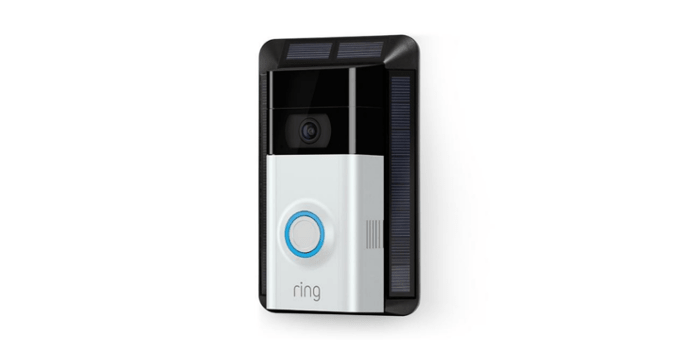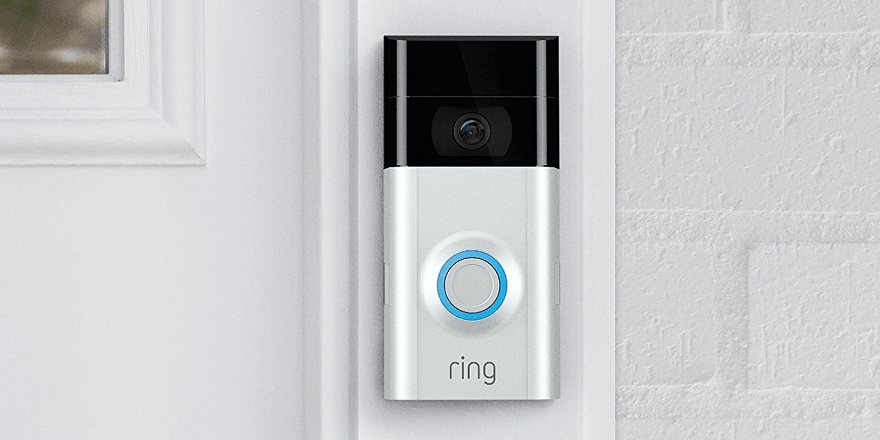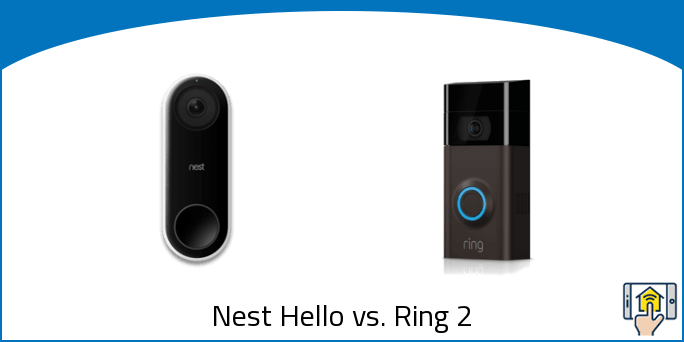Smart doorbells are a great way to keep an eye on the entryway of your home, and Nest and Ring are two well-known brands that offer their own take on the technology. When comparing the Nest Hello vs. Ring 2, we can’t in good conscience recommend the Nest Hello due to some security issues that they have yet to address.
Nest products generally have a reputation for high quality, and there’s no denying that the Nest Hello has a lot to offer. However, the Ring 2 brings a lot to the table as well and manages to do so without the major drawbacks that make the Nest Hello so difficult to recommend. While a long lineup of features is certainly exciting, the superior security of the Ring 2 proves that it’s the execution that really matters.
Below we take a look at the Nest Hello and Ring 2 to show you where these doorbells excel and where they fall short. Read on for a comprehensive review, or jump directly to the sections that interest you most using our navigation bar.
Nest Hello vs. Ring 2 — Differences
-
Difference #1: Power Options – The first difference worth discussing when comparing the Ring Doorbell 2 vs. Nest Hello is the different options available for power.
Both models can be powered by hardwiring into an existing doorbell kit, and are compatible with 16-24 VAC doorbell transformers. They will not work with DC transformers, so if that’s part of your existing setup or you’re worried about not having enough power to run the cameras, consider upgrading it to the Honeywell Transformer for the compatibility and extra voltage you’ll need.
With the Nest Hello, that hardwiring is your only option. The Ring 2, on the other hand, also allows you to run the bell using a rechargeable battery that lasts 6 months on a single charge.
If you’re not comfortable with messing with doorbell wiring and don’t want to bring in a professional for installation, the Ring 2 is the clear choice due to the extra flexibility of battery power.
-
Difference #2: Aspect Ratio – The Nest Hello And Ring 2 both offer HD recording capabilities, so you’ll get a high-quality picture regardless of your choice. However, the Nest Hello records at a 4:3 aspect ratio while the Ring is more standard at 16:9.
The significance of this difference is that the Nest Hello has more height to the picture, which avoids the issue of footage with parts of a person completely out of the frame. While the Ring 2 does do a good job of capturing your entire yard, it does struggle to capture the full height of a person, while the Nest Hello has a more narrow recording with the height to keep an entire person within the frame.
The two aren’t exactly the same from video quality perspective either. The Ring app has 1080p footage recorded at 15 FPS, while the Nest Hello records 1600 x 1200 HD footage at 30 FPS. This means you’ll get smoother video from the Nest. Only the Nest has HDR capabilities, which will give you sharp details even in bright and dark areas.
Overall, the Nest Hello is a little better when it comes to the quality and utility of the doorbells’ recording.
-
Difference #3: Field of View – The Nest Hello may do a better job of keeping an entire person in the shot as they come up to your door, but the Ring 2 is better at keeping an eye on the entirety of your front yard with a 188.7° diagonal vs. 160° diagonal field of view.
-
Difference #4: Intelligent Motion Detection – The Nest Hello and Ring 2 both feature motion detection, although they do differ in the types of features that they offer.
By default, the Nest Hello includes personal alerts and facial recognition, which leads to greater accuracy when it comes to sending alerts. If you opt for the Nest Aware subscription, you’ll also have access to motion zones that allow you to individually adjust sensitivity levels within the field of view, but that isn’t available unless you pay extra.
With the Ring 2, motion zones and person alerts are both available for free, although person alerts will only work when the camera is plugged in due to the intense power requirements. Unfortunately, there is no facial recognition available with Ring.
If you’re comfortable paying a monthly fee, Nest does offer the Facial Recognition feature which puts it ahead of Ring. If you’re looking for the most bang for your buck without paying for a subscription, however, the Ring 2 is the clear choice due to the inclusion of motion detection without any additional charges.
-
Difference #5: Free Cloud Storage – Nest technically has the edge when it comes to free cloud storage, but that’s not really saying much. With 3 hours of snapshots, you’ll be able to view activity that happened very recently, but outside of that, you’re going to be out of luck.
Still, that’s better than the Ring 2 that doesn’t offer any sort of storage unless you pay for a subscription.
If you’re looking for the ability to save and view footage, you’re really going to be better off with a subscription plan with either brand. We’ll discuss that in more detail below!
-
Difference #6: Subscription & CVR – Nest and Ring both use a subscription model that offers extra storage and features in varying tiers.
Nest’s subscription plan is known as Nest Aware, and is broken into three plans named after the length of video history that they offer. The 5-day plan costs $5/month, the 10-day costs $10/month, and the 30-day costs $30/month. All three plans offer a slight discount if you pay annually rather than monthly as well.
The only real difference between the three tiers is that video history, as all plans offer intelligent alerts, clips and time-lapses, activity zones, and continuous video recording (CVR). The CVR feature across all cameras for a single monthly fee is pretty rare and is one of the biggest advantages that Nest Hello has to offer.
The Ring 2 has no option for CVR. However, that doesn’t mean that their plans aren’t competitive as well!
Ring has three plans: Free, Protect Basic, and Protect Plus.
With the free plan, you’ll have access to Ring and Motion Alerts, Custom motion detection, live video on demand, and the ability interact with visitors from anywhere.
Protect Basic covers a single Ring Doorbell or Security camera, and costs $3/month or $30/year. This plan adds in the ability to access videos of every activity event for up to 60 days, as well as review, share, and save those videos.
If you opt for the Protect Plus Plan at $10/month or $100/year, your subscription will cover all of the Ring devices at a single address. In addition to all the features offered with the Protect Basic Plan, you’ll have an extended warranty beyond the standard 1-year, access to Ring Alarm professional monitoring, and 10% off all purchases at ring.com.
When comparing these plans side by side, it’s obvious that the CVR feature offered with Nest Aware is a major benefit that Ring is lacking. However, we’re not big fans of the way that Nest approaches their subscription since they lock motion zones behind a monthly fee.
With Ring, you’re essentially paying for access to cloud storage and can forgo the plan completely if you don’t feel the need to download videos. With Nest, on the other hand, you need to pay a monthly fee just to unlock some of the basic functionality that is built into the camera by default. If Nest were to adjust their model and include motion zones for free, we’d be much bigger fans.
-
Difference #7: Compatible Networks – There are also some differences in the way that these two doorbells connect to your network.
The Ring 2 uses an 802.11 b/g/n WiFi connection, but it can only communicate over the 2.4 GHz band. This means that your network might experience some congestion due to the inability of the doorbell to spread its data transmission out over a wider range of frequencies.
The Nest Hello, on the other hand, works with WiFi 802.11a/b/g/n/ac and is a dual-band device with support for 2.4GHz and 5GHz channels. Because of the more advanced technology, you shouldn’t really notice your network slowing down at all. The Nest Hello also uses Bluetooth Low Energy (BLE) and 802.15.4 at 2.4GHz for setup and to connect to other Nest devices.
Long story short, Nest is the better choice from a network compatibility standpoint since it’s a dual-band device.
-
Difference #8: Live View On Demand – Live View is a standard feature on both cameras, but it’s important to note that the feature won’t work with the Ring 2 unless you’ve hardwired it into your doorbell kit. When running on battery power, you won’t be able to access the live view on demand since the power need is too high.
Since the Nest Hello only has a hardwired option, this isn’t really something you have to worry about. With that said, with both doorbells wired into your doorbell transformer, there’s really no difference — it’s just the battery-powered option that locks you out from certain features.
-
Difference #9: Pre-Recorded Responses – Sometimes you aren’t able to get to the door right away, and the Nest Hello offers a solution to that issue with Pre-Recorded Responses. If someone walks up to your door and you’d like to respond remotely rather than in person, you can respond from the Nest app notification with three quick responses: “You can leave it,” “We’ll be right there,” or “No one can come to the door.”
Unfortunately, there’s currently no option to create your own pre-recorded message, but it’s still a point in Nest’s favor considering there’s no analogous feature available on the Ring 2.
-
Difference #10: Silent Mode – Being able to silence the doorbell is a great perk for when you don’t want to be disturbed, and Nest Hello allows you to disable the indoor chime for a specified amount of time using the “Quiet Time” feature.
The Ring 2 doorbell does not have any such feature. However, if you decide to pair your Ring 2 with a Ring Chime or Chime Pro, you’ll be able to silence the ring Chime using the smartphone app.
-
Difference #11: Operating Temperature – Both cameras can stand up to a decent range of temperatures, but the Ring 2 is a lot more durable at a range of -5° – 120°F (-20° – 50°C) vs. the Nest Hello’s 14° – 104°F (–10° – 40°C). With that said, if you’re looking for a camera that can stand up to very extreme temperatures, we recommend taking a look at the Skybell HD.
While the Ring 2 should be more than sufficient in most climates, you may actually run into issues with the Nest Hello since there are quite a few areas that get hotter or colder than that range from time to time.
-
Difference #12: Voice Control – Voice control through programs like Amazon Alexa and Google Assistant is supported with both devices. You can even pull up video on devices like the Echo Show or Echo Spot in order to get a live view of your front door directly on your chosen smart device.
If you’re looking to access your video feed from the Google Home Hub, however, your only option is Nest. While Ring 2 supports Google Assistant for voice control, the video display is only possible on Amazon-branded devices.
Simply put, the Nest Hello offers more flexibility and has the edge — especially for those invested in the Google ecosystem.
-
Difference #13: Color – While color might not be a crucial part of the decision-making process, it’s always nice to have a smart doorbell that will blend in seamlessly with the exterior of your home. The Nest Hello has a Black & White color scheme, but there are also a number of skins available.
The Ring 2 includes two interchangeable faceplates, which gives you the ability to pick and choose how you’d like your bell to look and swap things in and out at will.
-
Difference #14: Warranty – Last, but certainly not least, are the differences in warranty length. Your Nest Hello will be covered for 2 years, while the Ring 2 is only covered for 1. You can extend the warranty with Ring if you opt for their highest tier plan, but as a baseline, the coverage is less impressive.
If you’re worried about running into issues with your new doorbell, that extra year of protection could help add some extra peace of mind.

Nest Hello vs. Ring 2 — Comparison Chart
| Nest Hello | Ring Video Doorbell 2 | |
|---|---|---|
| Power Options | Hardwire to existing doorbell kit only |
Hardwire to existing doorbell kit or Rechargeable battery power |
| Battery Life | N/A | ~6 months with regular use |
| Compatible Doorbell Transformers | 16V AC–24V AC; requires a 10VA transformer and wired doorbell |
16-24 VAC, DC not compatible |
| Video Resolution | 1600 x 1200 HD UXGA, HDR | 1080p HD |
| FPS | 30 FPS | 15 FPS |
| Field of View | 160° diagonal | 160° horizontal, 100° vertical |
| Zoom | Yes | Yes |
| Night Vision | 850 nm infrared LEDs | Black & White |
| Free Cloud Storage | 3 hours of snapshots | No |
| Subscription Available | Yes | Yes |
| Compatible Networks | 2.4GHz or 5GHz 802.11a/b/g/n/ac Bluetooth Low Energy (BLE) 802.15.4 at 2.4GHz |
2.4GHz 802.11 b/g/n |
| Motion Detection | Yes | Yes |
| Motion Zones | Yes | Yes |
| Person Alerts | Yes | Yes, if wired |
| Facial Recognition | Yes | No |
| Live View On Demand | Yes | Only if Wired |
| 24/7 CVR | Yes | No |
| Two-Way Audio | HD Talk and Listen | Yes |
| Pre-Recorded Responses | Yes | No |
| Silent Mode | Yes | No |
| Operating Temperature | 14° – 104°F (–10° – 40°C) |
-5° – 120°F (-20° – 50°C) |
| App | Android, iOS, Web | Android, iOS, Web |
| Smart Home Integration | Amazon Alexa, Google Home Hub, Google Home Mini |
Amazon Alexa, Google Assistant (no Google Hub Support), IFTTT |
| Colors | Black & White, skins available | Includes two interchangeable faceplates |
| Size | 1.7 x 4.6 x 1.0 in (4.3 x 11.7 x 2.6 cm) |
5.1 x 2.5 x 1.1 in (12.8 x 6.4 x 2.7 cm) |
| Warranty | 2 years | 1 year |
Nest Hello vs. Ring 2 — Things in Common

-
Zoom – From a security standpoint, it’s important that cameras have the ability to zoom in order to better capture the details. Fortunately, both the Nest Hello and Ring 2 include a zoom feature.
-
Night Vision – Night time is often when your home is most at risk, and both cameras keep your home protected 24/7 in a clear black and white picture from infrared LEDs.
-
Motion Detection – Your cameras are ready and waiting to detect activity and will send you a notification in the event that they sense motion. That motion detection will also trigger a recording that you can go back and review later on.
-
Two-Way Audio – A two-way audio feature on both models allows you to both listen in on the action and yell at package thieves to keep your deliveries safe. It’s also a great feature in day-to-day use as well, since you can communicate with visitors without having to walk up to the door.
-
App Support – Controlling your Nest Hello or Ring 2 should be a breeze regardless of your choice in device with app support for Android, iOS, and Web.
Nest Hello vs. Ring 2 — Accessories

Since Nest and Ring are both pretty established brands, there are some accessories and extra products that we feel would integrate quite well with your new smart doorbell.
The Nest Hello Case is a great buy for giving your doorbell a fresh look and some extra durability. From an installation standpoint, the can help with positioning, and this Power Supply is great to have in case your house is not hardwired for a doorbell.
The Ring 2 is compatible with the Ring Chime to make a more complete and intelligent doorbell unit. There’s also the option for the Ring Chime Pro, which includes a WiFi extender in addition to the features of the Ring Chime.
You may also be in a Power Adapter or to make powering your Ring 2 more convenient, as well as this Adjustable (30 to 55 Degree) Angle Mount for a more convenient installation.
No products found.
Nest Hello vs. Ring 2 — Our Thoughts

This comparison of the Ring 2 vs. Nest Hello may give the impression that the Nest Hello is the better choice, but there are some glaring issues that aren’t really apparent at first glance. While the Nest Hello looks good on paper, there are some significant flaws in its execution that can greatly impact how well it protects your home.
To begin with, Nest takes about 10 seconds to send a notification to your phone when it detects motion. This is awful from a security standpoint when time is of the essence, and is also just very inconvenient when you’re trying to use it as a doorbell as well. Nest had previously responded that they were aware of the issue, but have since retracted their statement and tried to erase any trace of it on the web. Users on reddit have also reported that people who bring up the delay are being banned from the Nest forum. The fact that the company had previously acknowledged the issue, only to backtrack and allegedly ban anyone who brings it up is seriously concerning.
The Nest Hello also has a very long cooldown between notifications for detected motion, which can sometimes be as long as 30 minutes. There are no doubt situations where there are going to be multiple motion events within that time period, and the fact that Nest won’t bring them to your attention is a major flaw.
Lastly, while the two-way audio feature with the Nest Hello does work quite well, video recordings will only capture the audio from the person being recorded and not the audio spoken through the app. This can create serious problems when you’re trying to use the footage as evidence since your own voice won’t be detected.
There are a lot of advantages that Nest Hello has over Ring 2, but because of these issues, we can’t recommend the product in good conscience at this time. Ring 2 offers many of the same benefits, the subscription plans are cheaper, and there aren’t any major technical issues, so we feel that it’s currently the superior choice.
Last update on 2024-04-19 at 22:14 / Affiliate links / Images from Amazon Product Advertising API




shill much?
Lol, thanks for your analysis brian.
– Joseph
Thanks for the comprehensive review. Just wanted to let you know that I run off of battery on my Ring 2 and can actually use live view. Your note above indicates that live view wasn’t available u less it was hardwired.